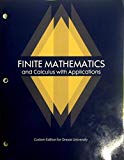
Concept explainers
(a)
To find: The probability that the letter is in drawer 1.
(b)
To find: The probability that the letter is in drawer 2, given that the letter is not in drawer 1.
(c)
To find: The probability that the letter is in drawer 3, given that the letter is not in drawer 1 or 2.
(d)
To find: The probability that the letter is in drawer 8, given that the letter is not in drawers 1 - 7.
(e)
To explain: What’s happening to the probability when the letter is in next drawer, comparing the results from parts (a) to (d).
(f)
To find: The probability that the letter is in some drawer.
(g)
To find: The probability that the letter is in some drawer, given that the letter is not in drawer 1.
(h)
To find: The probability that the letter is in some drawer, given that the letter is not in drawer 1 or 2.
(i)
To find: The probability that the letter is in some drawer, given that the letter is not in drawer 1 - 7.
(j)
To explain: What’s happening to the probability when the letter is in some drawer, comparing the results from parts (f) to (i).
Want to see the full answer?
Check out a sample textbook solution
Chapter 7 Solutions
Finite Mathematics and Calculus with Applications
- Find the indefinite integral. Check Answer: 7x 4 + 1x dxarrow_forwardQuestion 1: Evaluate the following indefinite integrals. a) (5 points) sin(2x) 1 + cos² (x) dx b) (5 points) t(2t+5)³ dt c) (5 points) √ (In(v²)+1) 4 -dv ขarrow_forwardFind the indefinite integral. Check Answer: In(5x) dx xarrow_forward
- Find the indefinite integral. Check Answer: 7x 4 + 1x dxarrow_forwardHere is a region R in Quadrant I. y 2.0 T 1.5 1.0 0.5 0.0 + 55 0.0 0.5 1.0 1.5 2.0 X It is bounded by y = x¹/3, y = 1, and x = 0. We want to evaluate this double integral. ONLY ONE order of integration will work. Good luck! The dA =???arrow_forward43–46. Directions of change Consider the following functions f and points P. Sketch the xy-plane showing P and the level curve through P. Indicate (as in Figure 15.52) the directions of maximum increase, maximum decrease, and no change for f. ■ 45. f(x, y) = x² + xy + y² + 7; P(−3, 3)arrow_forward
- EX-let d'be ametric on a vector space X induced from a norm hx and d defind by a Slab)= {od (a, if a = b (a,b)+is ab Show that cannot be induced froman norm on X. 2) let à be trivel metric show that I cannot be induced from an norm on X- 3) let M be closed subspace of anormed spacex Construct the space X/Mas a normed space. 4) let Mix be vector space of 2x3 matrices on R write with Prove convex set and hyper Plane of M 5) show that every a finite dimension subspace of anormed space is closed.arrow_forwardplease do #48arrow_forward43–46. Directions of change Consider the following functions f and points P. Sketch the xy-plane showing P and the level curve through P. Indicate (as in Figure 15.52) the directions of maximum increase, maximum decrease, and no change for f. ■ 45. f(x, y) = x² + xy + y² + 7; P(−3, 3)arrow_forward
 College Algebra (MindTap Course List)AlgebraISBN:9781305652231Author:R. David Gustafson, Jeff HughesPublisher:Cengage Learning
College Algebra (MindTap Course List)AlgebraISBN:9781305652231Author:R. David Gustafson, Jeff HughesPublisher:Cengage Learning Holt Mcdougal Larson Pre-algebra: Student Edition...AlgebraISBN:9780547587776Author:HOLT MCDOUGALPublisher:HOLT MCDOUGAL
Holt Mcdougal Larson Pre-algebra: Student Edition...AlgebraISBN:9780547587776Author:HOLT MCDOUGALPublisher:HOLT MCDOUGAL


